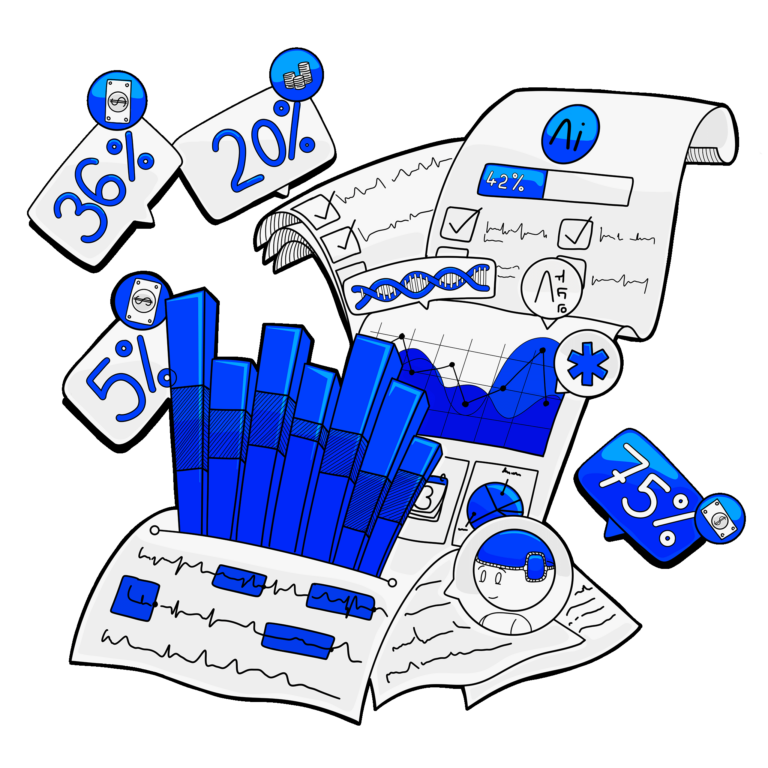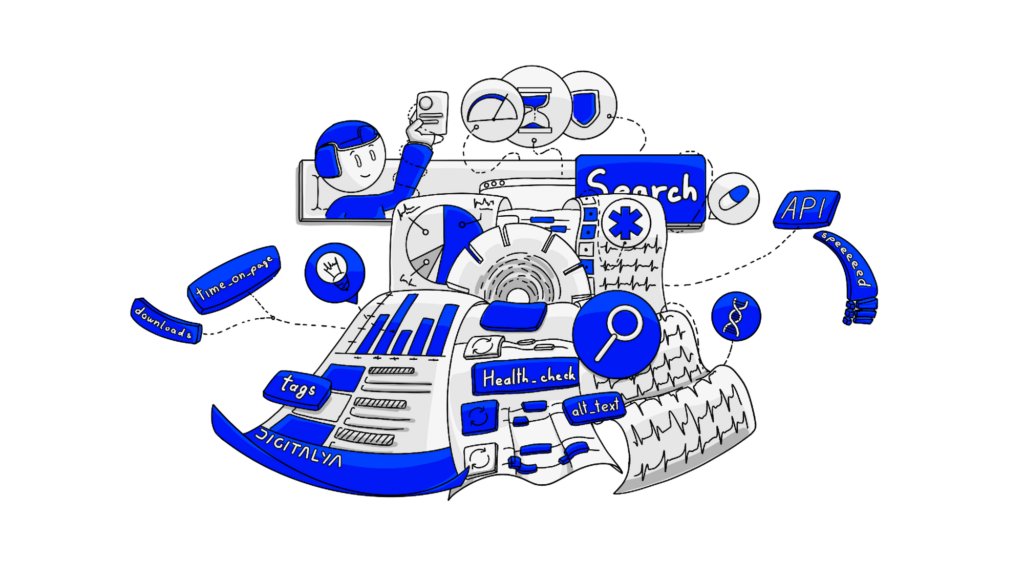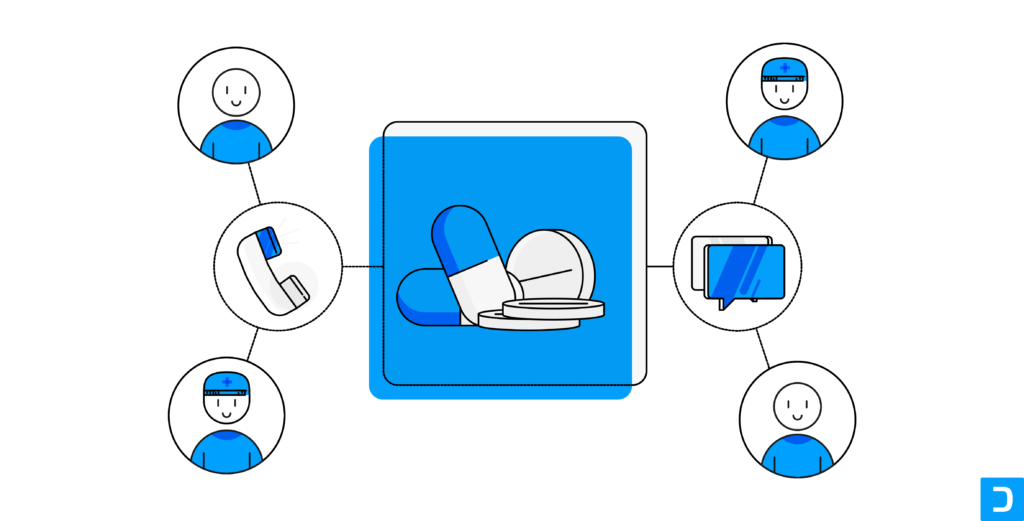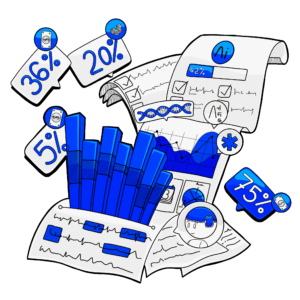Omnichannel strategies in pharma — from buzzword to business driver
HCP inboxes are saturated and field access is shrinking; pharma’s traditional engagement models are rapidly losing relevance. Yet the industry’s answer — more digital channels, more tech layers — has often led to noise rather than nuance.
Omnichannel marketing in pharma promises to fix that. A customer-centric approach is a core element of omnichannel marketing in pharma, focusing on understanding customer needs and creating seamless, personalized experiences across all channels. But not the way it’s often sold.
It’s not about layering on tools. It’s not about marketing automation or CRM dashboards alone. A true omnichannel strategy is a shift in how organizations think: from pushing isolated messages to orchestrating coherent, adaptive journeys across medical, commercial, and digital teams.
Unlike traditional marketing tactics, a customer-centric strategy prioritizes the needs and preferences of HCPs and patients to deliver more relevant and engaging experiences.
Pharma companies treat omnichannel marketing as a campaign tactic will fall behind. Those that embed it as a strategic operating model, rooted in behavior, compliance, and customer value, will own the future of HCP engagement.
What makes pharma omnichannel unique?
Unlike retail or tech, pharma operates in a landscape defined by complexity. It’s about audiences with clinical expectations, content governed by regulation, and teams that don’t always speak the same language.
Here’s what sets pharma apart when it comes to omnichannel strategy:
- Compliance is the blueprint
Every touchpoint must meet legal, regulatory, and privacy standards. That means modular content, clear consent tracking (such as GDPR), and fast but safe medical-legal review processes.
- Your customer isn’t one person
Engagement involves HCPs, patients, pharmacists, and internal teams. A brand’s success may hinge on coordinated journeys across all of them, each with different informational needs and roles in the prescribing path.
- Content is more than marketing
Unlike industries where the product is the message, pharma relies on a mix of promotional and non-promotional content, delivered via reps, MSLs, email, events, and educational platforms.
- Digital must augment, not replace, the human element
Healthcare professionals still value personal interaction. The goal of omnichannel is not to eliminate reps or MSLs — it’s to make every interaction smarter, more timely, and more personalized.
For the pharmaceutical industry, omnichannel isn’t just a marketing challenge — it’s a cross-functional transformation problem.
Breaking the multichannel illusion
Many pharma companies believe they’ve embraced omnichannel when in reality, they’re still stuck in multichannel marketing: using multiple platforms, but in disconnected, static ways. Without coordination and context, even well-funded omnichannel pharma marketing programs can feel fragmented.
Let’s break it down:
- Multichannel marketing = multiple channels
Pharma companies now leverage reps, emails, webinars, portals, and social. But most of these operate in silos, with limited visibility across teams. The result? Repetition, inconsistency, and disengagement. Integrating different channels effectively is a major challenge, but it is essential for delivering a seamless customer experience.
- Omnichannel = orchestrated, context-aware journeys
Omnichannel marketing goes beyond coexistence. It requires coordination.
- If an MSL meets with an oncologist today, the system should suppress unrelated email campaigns the following day.
- If an HCP clicks a piece of content efficacy, the next touchpoint should build on that interest, not restart the story.
Why does this matter in pharma?
Unlike multichannel marketing, which focuses on reach, omnichannel marketing efforts emphasize relevance and timing.
- HCP attention is scarce, and fragmented messaging erodes trust.
- Overcommunication is risky. Regulatory scrutiny increases when touchpoints aren’t harmonized.
- Internal inefficiency is costly. When sales, medical, and marketing efforts aren’t aligned, engagement quality suffers.
- Delivering the right message to HCPs at the right time is crucial for engagement and ensures communications are both relevant and effective.
True omnichannel doesn’t just connect channels; it also integrates them. It connects purpose, message, and timing.
The strategic pillars of effective omnichannel in pharma
A high-performing omnichannel strategy isn’t about doing more — it’s about doing the right things, in the correct order, with the right coordination. Engaging across multiple channels is only valuable when interactions feel connected and personalized. Efforts should be structured around four strategic pillars:
- Persona-driven orchestration
Effective omnichannel engagement is rooted in dynamic personalization based on behavior, preferences, and context.
- Dynamic personas should evolve based on prescribing behavior, digital engagement, content preferences, and specialty.
- Systems must support adaptive sequencing so that each customer experience adjusts in real time, whether they engage with an email, attend a webinar, or speak with an MSL.
- Building detailed customer profiles enables more personalized engagement, ensuring that each touchpoint is relevant to the HCP’s interests and needs.
- Creating content that is adaptable and modular is essential for delivering the right message at the right time across different channels.
Example: an HCP who ignored promotional content but interacts with clinical data may shift into a scientific-first sequence supported by MSL touchpoints.
- Compliance and privacy design
Regulations shouldn’t be viewed as blockers. In omnichannel marketing, they become design constraints that force creativity.
- Use modular content — approved building blocks that can be reused across channels with speed and control.
- Integrate MLR approval into content creation workflows early, not retroactively.
- Make consent tracking intuitive for HCPs and visible across all engagement systems.
- Employ a variety of content formats to meet both regulatory requirements and the diverse needs of your audience.
- Outcome-oriented measurement
Clicks and opens are table stakes. Pharma leaders should focus on metrics that reflect behavioral impact and commercial intent:
- Sequence completion rates
- Time to engagement after rep/field interaction
- Conversion to key actions
Build closed-loop dashboards that unify data across systems and translate engagement into actionable insights. Leverage dynamic analytics to enable real-time optimization of campaigns and strategies. Make data-driven decisions based on unified dashboards to continually refine and improve omnichannel performance.
- Platform-agnostic integration
A channel is only as smart as the system behind it. Pharma needs a flexible architecture that connects CRM, marketing automation, content management, and analytics, without being trapped in vendor lock-in.
- Ensure bi-directional sync between rep tools (like Veeva, IQVIA) and digital platforms
- Orchestrate journeys, not campaigns, with the ability to pause, redirect, or adapt content mid-stream based on real-time signals
- Integrate data from multiple sources to create a unified view of the HCP, accessible by field, marketing, and medical teams alike
Partnering with industry experts can help develop tailored solutions for omnichannel strategies, ensuring your approach is customized to your organization’s unique needs.
Cross-functional alignment — the hidden enabler
Even the most well-designed omnichannel strategies will fail without organizational alignment. The reality? Most pharma companies still operate in functional silos — marketing, medical, commercial, IT, and legal — all with different goals, KPIs, and timelines. Achieving omnichannel success requires global teams to work together seamlessly, ensuring collaboration across local and international markets.
Omnichannel engagement success requires breaking those silos and forming a unified operating model centered on the HCP journey.
- Medical affairs
Medical teams often guard the most valuable content, like scientific literature, clinical data, and peer-reviewed resources. But their insights rarely reach HCPs in a coordinated way.
- Role: shape non-promotional journeys and ensure scientific accuracy in content across channels.
- Integration tip: allow digital sequencing to incorporate MSL engagements as high-value touchpoints.
- Commercial and field teams
Sales teams have direct access to HCPs, but often lack visibility into digital behaviors — and vice versa.
- Role: close the loop on interest signals captured online.
- Integration tip: equip reps with digital interaction histories and recommended next best actions.
- Marketing and content teams
These teams drive much of the content output, but often overproduce or deliver inconsistently across touchpoints. By collaborating with other functions, marketing and content teams play a key role in developing smarter campaigns that are more personalized and data-driven.
- Role: orchestrate personalized, modular content that aligns with real-world engagement flows.
- Integration tip: collaborate closely with compliance to pre-approve content blocks for agile reuse.
- IT, data, and analytics
Often seen as the back-end support, IT and analytics are in fact central to omnichannel orchestration. These teams enable smarter campaigns by providing improved customer insights, which help drive better decision-making and personalization.
- Role: build infrastructure for real-time personalization, journey mapping, and closed-loop reporting.
- Integration tip: involve them early in strategy, not just in implementation, to ensure scalable design.
- Compliance and legal
They aren’t just “approvers.” Their guidance can either delay or empower omnichannel execution.
- Role: define boundaries for channel use, consent handling, and promotional activity.
- Integration tip: move from ad hoc approvals to framework-based governance and modular content reviews.
When teams co-own customer experience and speak a shared language around journeys, omnichannel strategies stop being an initiative and become an operational standard.
Designing an end-to-end consistent customer experience
Omnichannel pharma marketing isn’t about sending the same message across every digital channel. It’s about intelligently sequencing content and touchpoints based on what an individual HCP needs, at the right time, in the right format, through the right team. Omnichannel strategies can significantly boost customer engagement with HCPs, leading to higher revenue and improved marketing efficiency.
- Start with the objective, not the asset
- What decision are you trying to influence?
- What behavior do you want to drive?
- What does the HCP need to feel, know, or do next?
Every digital journey should be reverse-engineered from a clinical or commercial objective, not from a content calendar.
- Map the customer journey by role and channel
Different HCPs engage differently. A general practitioner exploring a new therapy may require broad disease awareness, while a specialist may need peer-reviewed efficacy data.
Example sequence:
Webinar invite → On-demand video → Rep-triggered follow-up email with clinical trial summary → MSL engagement → Retargeted LinkedIn post on peer usage trends.
Each step builds relevance and increases signal strength, leading to a more meaningful in-person or virtual interaction. Designing an engaging customer journey is essential for building meaningful relationships with HCPs and patients, moving beyond traditional one-sided communication.
- Use behavioral signals as journey triggers
Instead of fixed timelines, use real-time behaviors to inform the next step:
- Opened an email on safety? Trigger a medical Q&A asset.
- Skipped a disease awareness webinar? Suppress follow-ups and try a shorter visual.
- Engaged with MSL content? Offer gated advanced data via rep outreach.
It’s important to track the omnichannel journey across all touchpoints to ensure a seamless and personalized experience.
This creates a responsive, non-linear journey that feels natural to the HCP, increasing engagement velocity.
- Include off-ramps and recovery paths
Not every HCP will follow the ideal journey. Design fallback flows:
- For drop-offs → offer alternate formats (like video vs. article)
- For low engagement → trigger a preference center with tailored options
- For unsubscribes → trigger a preference center with tailored options
Leverage digital interactions to personalize recovery paths and ensure HCPs receive relevant content. Use targeted communications to re-engage HCPs who drop off the journey. More targeted communications can improve engagement and overall effectiveness by tailoring content to HCP profiles, preferences, and behaviors.
When done well, omnichannel journeys don’t just reach HCPs; they build trust, reduce friction, and drive informed clinical decisions.
Barriers to maturity and how to beat them
Even pharmaceutical companies with clear omnichannel engagement strategies often get stuck mid-journey. A strategy misfire can happen due to persistent, practical barriers across people, processes, and platforms.
Let’s discuss the top five challenges and how leading organizations are overcoming them:
- Siloed teams, siloed journeys
The issue: marketing, sales, medical, and IT often operate with disconnected goals and tech stacks. This results in duplicated messages, wasted effort, and a poor HCP experience.
The solution:
- Create cross-functional omnichannel task forces with shared KPIs
- Use HCP journey maps to align all stakeholders around a single experience vision
- Assign journey owners who coordinate across functions, not just within one team
- Compliance bottlenecks that delay execution
The issue: long MLR review cycles block campaign agility. Content is often approved asset by asset, not for reuse.
The solution:
- Adopt modular content frameworks: approve content blocks once, use them many times
- Pre-approve response libraries for field and digital teams
- Involve compliance early in journey design to align on risk zones
- Invest in new technology to streamline approval workflows and accelerate time to market
- Over-reliance on email as a default channel
The issue: email is easy, but also overused and underperforming. Many pharmaceutical companies send without orchestration, leading to fatigue.
The solution:
- Diversify — use webinars, rep-triggered videos, chatbots, peer panels, and social media ads
- Base channel mix on behavioral preference, not internal convenience
- Implement channel suppression logic to prevent over-messaging
- Lack of personalization at scale
The issue: static segment and broad messaging fail to reflect the HCP’s current interest or knowledge level.
The solution:
- Integrate CRM, behavioral, and consent data to fuel dynamic audience models
- Use AI tools or rules-based engines to personalize sequencing in real-time
- Focus on intent-based messaging, not just profile-based targeting
- Achieving true personalization requires a deep understanding of HCP needs, preferences, and behaviors
- Weak measurement infrastructure
The issue: disconnected systems and vanity metrics make it hard to link engagement to business impact.
The solution:
- Build unified dashboards that capture engagement across digital, field, and medical
- Define shared success metrics
- Use A/B testing frameworks to continuously optimize sequencing logic
Start by solving the bottlenecks that matter most to your HCPs. Then scale what works, and automate where you gain traction.
The omnichannel maturity ladder in pharma
Not all pharmaceutical companies start from the same place. Some are just beginning to explore digital channels; others are deploying predictive engagement engines. The key is to understand where you are today and what it takes to level up.
Let’s go through a four-stage model to guide your omnichannel strategy evolution:
| Stage | Traits | Symptoms | Focus |
| Ad-hoc — channel chaos | Disconnected campaigns, content duplication, little personalization, no unified HCP view | Predictive — AI enables personalization at scale | Audit current touchpoints and build cross-functional awareness |
| Connected — operational visibility | Basic CRM and rep-triggered emails, shared calendars, early segmentation efforts | Some coordination between teams, but still slow adaptation and inconsistent messaging | Centralize data, standardize content workflows, and establish shared governance models |
| Orchestrated — journey-driven engagement | Persona-based sequencing, modular content, behavioral triggers, aligned field-digital strategy | Better HCP engagement metrics, increased relevance, improved rep follow-up quality | Expand personalization, automate low-risk content deployment, and optimize end-to-end journeys |
| Predictive — AI enabled personalization at scale | Machine learning models predict next-best-action per HCP, real-time channel optimization, closed-loop analytics | Higher campaign ROI, measurable commercial impact, seamless HCP experiences | Refine journey logic continuously, integrate advanced analytics, scale globally with compliance in mind |
Understanding your current stage allows you to prioritize investments, align leadership, and define realistic success metrics for the next 6-12 months.
Closing the loop in omnichannel engagement — from action to insight
One of the greatest missed opportunities in pharma omnichannel marketing strategies execution is the failure to connect what HCPs do with what the business learns. Too often, engagement data sits on isolated dashboards.
Closing the loop means making every interaction measurable, interpretable, and actionable.
What does closed-loop mean in practice?
- Behavioral data — clicks, views, downloads, time on page
- Field insights — rep notes, objections, meeting outcomes
- Medical interactions — MSL summaries, scientific questions
- CRM signals — stage changes, contact frequency
- Outcome data — registrations, sample requests, Rx intent, pull-through
When these are integrated, they don’t just show what happened, they tell you why it worked (or didn’t) and what to do next.
Too many omnichannel programs are data-rich but insight-poor. To fix that, pharma leaders should:
- Move from vanity metrics to business-linked KPIs
- Use engagement scoring to prioritize follow-ups
- Continuously refine sequencing, format, and content type
As multichannel marketing becomes the norm, only companies that evolve toward true omnichannel will differentiate.
To make omnichannel pharma marketing truly impactful, insight must flow back into every next engagement. That’s how you build an engine of improvement; one that evolves with your audience, not just your strategy.







